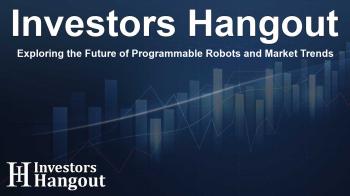Exploring the Future of Programmable Robots and Market Trends

Programmable Robots Market Growth Overview
The programmable robots market is emerging as a thriving sector with its size projected to escalate exponentially. With expectations to grow from USD 3.44 billion in 2023 to USD 13.22 billion by 2032, it demonstrates a robust compound annual growth rate (CAGR) of 16.16%. This growth can be attributed to the increased demand for automation and the rising integration of robotics in education, manufacturing, healthcare, and logistics.
Driving Forces Behind Market Expansion
As industries shift toward automation, programmable robots are gaining traction due to their ability to enhance accuracy, improve productivity, and reduce operational costs. Technological advancements, including artificial intelligence (AI), the Internet of Things (IoT), and machine learning, are pivotal in revolutionizing the capabilities of robotic systems. These innovations are transforming conventional notions of robots by adding features like autonomous functionalities and real-time monitoring.
Education and STEM Integration
In educational settings, programmable robots are becoming essential tools for teaching children STEM skills. By engaging with coding and problem-solving through interactive learning, students gain critical skills that are invaluable in today's tech-driven world. Schools and training programs across different regions are beginning to implement these technologies, significantly enhancing the learning experience.
Healthcare Applications and Opportunities
Moreover, healthcare applications for programmable robots have rapidly evolved. The rise of robotic solutions in surgery, rehabilitation, and elderly care underscores the fast-growing demand for automation in healthcare services. These robots contribute to efficiency in procedures, minimizing human errors, and improving patient care quality, providing considerable opportunities for growth within the market.
Analyzing Key Segments Impacting Market Dynamics
Market Segmentation by Component
The hardware segment holds a substantial share of approximately 64.5% within the programmable robots market. This significance is rooted in the necessity for reliable physical components, such as sensors and controllers. The demand for high-performance hardware is imperative as the field of robotics advances, emphasizing its role in the success of projects.
Software Innovations
Conversely, the software domain is anticipated to see the fastest growth. As companies increasingly adopt smart programming and autonomous functions, the reliance on software solutions is skyrocketing. Incorporating AI and cloud connectivity into programming enables robots to perform complex tasks efficiently, setting the stage for considerable transformations in various industries.
Regional Insights and Market Leaders
North America currently dominates the programmable robots market, capturing about 35.8% of the market share. This region benefits from robust industrial bases, early tech adoption, and high levels of research and development investment. Simultaneously, Asia Pacific is projected to experience remarkable growth rates, primarily driven by rapid industrialization and significant investments in technology.
Innovations from Leading Companies
Leading companies, such as LEGO Group and SoftBank Robotics, are at the forefront of this industry. For instance, LEGO's Mindstorms EV3 and SoftBank's NAO Robot are gaining acclaim for their educational value and usability in automation. Additionally, the recent launch of improved robots illustrates a commitment to enhancing user experience and learning possibilities.
Recent Developments and Future Outlook
Important recent developments include the launch of upgraded educational robots, such as Sphero's BOLT+, which focuses on providing enriched user experiences through enhanced coding features and real-time data display. Similarly, advancements like Makeblock's mBot Neo are aimed at educating younger audiences about programming and robotics, showcasing the ongoing innovation in the sector.
Frequently Asked Questions
What is the expected growth rate of the programmable robots market?
The market is expected to grow at a CAGR of 16.16% from 2024 to 2032.
Which industries are leading in the use of programmable robots?
Manufacturing, healthcare, and education sectors are leading the adoption of programmable robots.
What role does automation play in the growth of this market?
Automation drives the demand for programmable robots by improving efficiency, reducing costs, and minimizing human errors.
Which technologies are enhancing the capabilities of programmable robots?
AI, IoT, and machine learning are key technologies that enhance the functionalities of programmable robots.
Which regions are experiencing the fastest growth in this market?
Asia Pacific is expected to see the fastest growth due to industrialization and rising tech investments.
About The Author
Contact Dominic Sanders privately here. Or send an email with ATTN: Dominic Sanders as the subject to contact@investorshangout.com.
About Investors Hangout
Investors Hangout is a leading online stock forum for financial discussion and learning, offering a wide range of free tools and resources. It draws in traders of all levels, who exchange market knowledge, investigate trading tactics, and keep an eye on industry developments in real time. Featuring financial articles, stock message boards, quotes, charts, company profiles, and live news updates. Through cooperative learning and a wealth of informational resources, it helps users from novices creating their first portfolios to experts honing their techniques. Join Investors Hangout today: https://investorshangout.com/
The content of this article is based on factual, publicly available information and does not represent legal, financial, or investment advice. Investors Hangout does not offer financial advice, and the author is not a licensed financial advisor. Consult a qualified advisor before making any financial or investment decisions based on this article. This article should not be considered advice to purchase, sell, or hold any securities or other investments. If any of the material provided here is inaccurate, please contact us for corrections.

